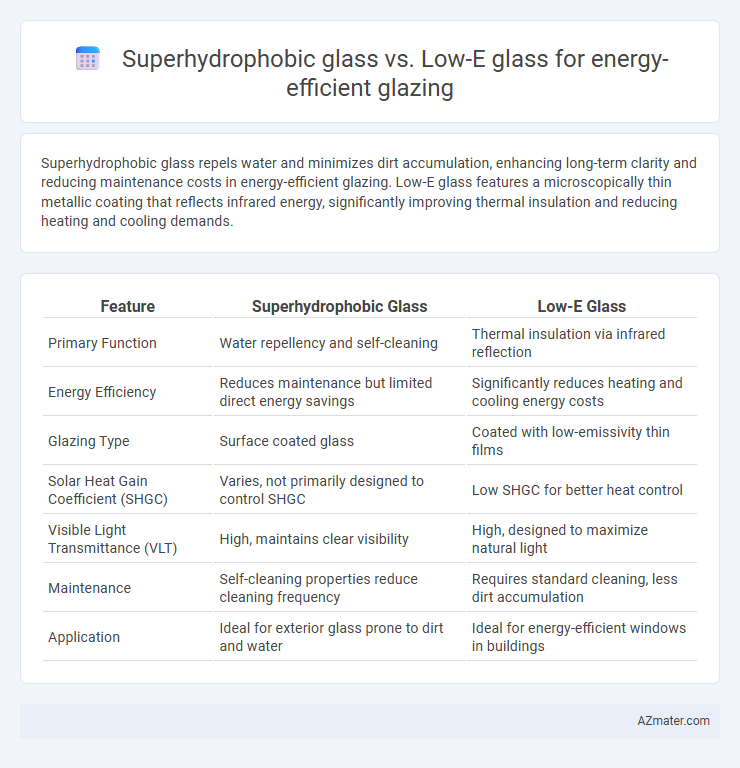Superhydrophobic glass repels water and minimizes dirt accumulation, enhancing long-term clarity and reducing maintenance costs in energy-efficient glazing. Low-E glass features a microscopically thin metallic coating that reflects infrared energy, significantly improving thermal insulation and reducing heating and cooling demands.
Table of Comparison
| Feature | Superhydrophobic Glass | Low-E Glass |
|---|---|---|
| Primary Function | Water repellency and self-cleaning | Thermal insulation via infrared reflection |
| Energy Efficiency | Reduces maintenance but limited direct energy savings | Significantly reduces heating and cooling energy costs |
| Glazing Type | Surface coated glass | Coated with low-emissivity thin films |
| Solar Heat Gain Coefficient (SHGC) | Varies, not primarily designed to control SHGC | Low SHGC for better heat control |
| Visible Light Transmittance (VLT) | High, maintains clear visibility | High, designed to maximize natural light |
| Maintenance | Self-cleaning properties reduce cleaning frequency | Requires standard cleaning, less dirt accumulation |
| Application | Ideal for exterior glass prone to dirt and water | Ideal for energy-efficient windows in buildings |
Introduction to Energy-Efficient Glazing
Energy-efficient glazing enhances building performance by reducing heat transfer and improving insulation. Superhydrophobic glass offers self-cleaning properties and water repellency, minimizing maintenance while maintaining transparency. Low-E glass features a thin metallic coating that reflects infrared radiation, significantly reducing heat gain and loss to optimize thermal efficiency.
What is Superhydrophobic Glass?
Superhydrophobic glass features a nanostructured coating that repels water, dirt, and contaminants, maintaining clarity and reducing maintenance needs for energy-efficient glazing applications. This self-cleaning property enhances solar transmission by minimizing surface soiling, which can degrade thermal performance over time. Compared to Low-E glass, which primarily reduces heat transfer through a thin metallic coating, superhydrophobic glass adds durability and cleanliness benefits, potentially improving overall energy efficiency in building facades.
Understanding Low-E Glass Technology
Low-E glass technology employs microscopically thin, transparent metal or metallic oxide coatings to minimize infrared and ultraviolet light penetration without compromising visible light transmission, significantly reducing heat transfer through windows. This technology enhances energy efficiency by reflecting interior temperatures back inside during winter and reflecting solar heat away during summer, thereby lowering heating and cooling costs. Compared to superhydrophobic glass, which primarily offers water repellency and self-cleaning properties, Low-E glass is specifically engineered for superior thermal insulation and energy performance in building glazing applications.
Key Differences in Glass Coating Technologies
Superhydrophobic glass features a nano-scale coating that repels water and dirt, enhancing self-cleaning properties and maintaining high transparency in energy-efficient glazing. Low-E (Low Emissivity) glass incorporates a microscopically thin metallic coating designed to reflect infrared radiation, reducing heat transfer and improving thermal insulation. While superhydrophobic coatings primarily improve surface cleanliness and durability, Low-E coatings focus on optimizing solar heat gain and minimizing energy loss in building applications.
Thermal Performance Comparison
Superhydrophobic glass and Low-E glass both enhance energy-efficient glazing but differ significantly in thermal performance. Low-E glass utilizes a microscopically thin metallic coating to reflect infrared radiation, reducing heat transfer and improving insulation by maintaining indoor temperature stability. Superhydrophobic glass primarily offers self-cleaning properties with water-repellent surface while its thermal insulation capabilities are generally less effective compared to the specialized reflective coatings in Low-E glass.
Impact on Daylighting and Visibility
Superhydrophobic glass enhances energy-efficient glazing by reducing water and dirt accumulation, which maintains optimal clarity and maximizes natural daylight transmission throughout the day. Low-E glass, designed with a thin metallic coating, selectively filters infrared and ultraviolet rays, improving thermal performance while preserving high visible light transmittance for clear indoor visibility. Both technologies contribute to daylighting efficiency, but superhydrophobic coatings ensure consistent visibility by preventing surface contamination, whereas Low-E glass focuses on spectral control to balance energy savings and natural illumination.
Energy Savings Potential
Superhydrophobic glass offers enhanced self-cleaning properties that maintain maximum solar transmittance, indirectly supporting energy savings by reducing maintenance-related efficiency loss. Low-E glass provides superior energy savings potential by selectively reflecting infrared radiation, significantly reducing heat transfer and lowering heating and cooling costs. Combining solar control benefits with improved thermal insulation, Low-E coatings are more directly effective in reducing energy consumption in energy-efficient glazing applications.
Durability and Maintenance Requirements
Superhydrophobic glass offers superior durability due to its self-cleaning properties, reducing dirt and water adhesion and minimizing maintenance needs. Low-E glass provides long-lasting energy efficiency but may require periodic cleaning to maintain optimal thermal performance, potentially increasing upkeep. Both types enhance energy savings, yet superhydrophobic coatings significantly extend glass lifespan by preventing surface degradation and reducing maintenance frequency.
Applications: Residential vs Commercial Use
Superhydrophobic glass excels in residential applications by providing self-cleaning properties that reduce maintenance in homes and enhance aesthetic appeal. Low-E glass, with its superior thermal insulation, is preferred in commercial buildings to optimize energy efficiency by minimizing heat transfer and lowering HVAC costs. Combining both technologies can benefit mixed-use buildings by improving durability and energy performance, though cost considerations often influence the choice between them.
Choosing the Right Glazing for Your Project
Superhydrophobic glass offers superior water repellency and self-cleaning properties, reducing maintenance costs while maintaining high transparency for energy-efficient glazing. Low-E glass enhances thermal insulation by reflecting infrared radiation, significantly decreasing heat loss and improving indoor comfort in both residential and commercial buildings. Selecting the right glazing involves balancing factors such as climate, maintenance needs, and energy savings, with superhydrophobic glass excelling in durability and Low-E glass optimizing thermal performance.

Infographic: Superhydrophobic glass vs Low-E glass for Energy-efficient glazing
 azmater.com
azmater.com